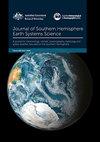Seasonal climate summary southern hemisphere (summer 2015-16): strong El Niño peaks and begins to weaken
IF 3.6
4区 地球科学
Q1 Earth and Planetary Sciences
引用次数: 0
Abstract
Southern hemisphere circulation patterns and associated anomalies for austral summer 2015-16 are reviewed, with an emphasis on the tropical Pacific as well as Australian rainfall and temperatures. Following the peak of El Niño in November 2015, summer 2015-16 featured continued near-record El Niño conditions in the tropical Pacific but saw the emergence of cooler subsurface waters in the equatorial Pacific. A moderate Madden Julian Oscillation (MJO) pulse and positive Southern Annular Mode (SAM) ontributed to average to above average rainfall across much of Australia, while the Maritime Continent and parts of far northern Australia saw continued below average rainfall.Sea surface temperatures during summer 2015-16 were the warmest on record for the southern hemisphere oceans, with very warm ocean temperatures in the Indian Ocean and Australian region, including the warmest summer sea surface temperatures on record around Tasmania. Air temperatures were also warmer than normal across Australia throughout the season, with a significant heatwave in southeast Australia during December.南半球(2015- 2016年夏季):强厄尔尼诺Niño达到峰值并开始减弱
回顾了2015- 2016年南半球夏季的南半球环流模式和相关异常,重点关注了热带太平洋以及澳大利亚的降雨和温度。在2015年11月厄尔尼诺Niño达到峰值之后,2015-16年夏季,热带太平洋的厄尔尼诺Niño持续接近创纪录水平,但赤道太平洋的地下水出现了较冷的现象。中等的马登朱利安涛动(MJO)脉冲和正的南环模(SAM)导致澳大利亚大部分地区的降雨量平均到高于平均水平,而海洋大陆和澳大利亚北部的部分地区则持续低于平均水平。2015-16年夏季的海面温度是南半球海洋有记录以来最热的,印度洋和澳大利亚地区的海洋温度非常温暖,包括塔斯马尼亚岛周围的夏季海面温度也是有记录以来最热的。整个季节澳大利亚的气温也比正常温度高,12月澳大利亚东南部出现了一股明显的热浪。
本文章由计算机程序翻译,如有差异,请以英文原文为准。
求助全文
约1分钟内获得全文
求助全文
来源期刊

Journal of Southern Hemisphere Earth Systems Science
Earth and Planetary Sciences-Oceanography
CiteScore
8.10
自引率
8.30%
发文量
0
审稿时长
>12 weeks
期刊介绍:
The Journal of Southern Hemisphere Earth Systems Science (JSHESS) publishes broad areas of research with a distinct emphasis on the Southern Hemisphere. The scope of the Journal encompasses the study of the mean state, variability and change of the atmosphere, oceans, and land surface, including the cryosphere, from hemispheric to regional scales.
general circulation of the atmosphere and oceans,
climate change and variability ,
climate impacts,
climate modelling ,
past change in the climate system including palaeoclimate variability,
atmospheric dynamics,
synoptic meteorology,
mesoscale meteorology and severe weather,
tropical meteorology,
observation systems,
remote sensing of atmospheric, oceanic and land surface processes,
weather, climate and ocean prediction,
atmospheric and oceanic composition and chemistry,
physical oceanography,
air‐sea interactions,
coastal zone processes,
hydrology,
cryosphere‐atmosphere interactions,
land surface‐atmosphere interactions,
space weather, including impacts and mitigation on technology,
ionospheric, magnetospheric, auroral and space physics,
data assimilation applied to the above subject areas .
Authors are encouraged to contact the Editor for specific advice on whether the subject matter of a proposed submission is appropriate for the Journal of Southern Hemisphere Earth Systems Science.
 求助内容:
求助内容: 应助结果提醒方式:
应助结果提醒方式:


